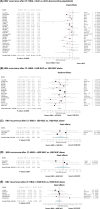Immunoglobulin, nucleos(t)ide analogues and hepatitis B virus recurrence after liver transplant: A meta-analysis
- PMID: 33866547
- PMCID: PMC8365701
- DOI: 10.1111/eci.13575
Immunoglobulin, nucleos(t)ide analogues and hepatitis B virus recurrence after liver transplant: A meta-analysis
Abstract
Background: Prophylaxis with hepatitis B immunoglobulin (HBIG) represents an efficient strategy for reducing the risk of hepatitis B virus (HBV) recurrence after liver transplantation (LT). Unfortunately, the long-term use of HBIG presents high costs. Therefore, the use of prophylaxis based only on nucleos(t)ide analogues (NUC) has been recently postulated. The present meta-analysis aimed to evaluate the impact of HBIG ± NUC vs HBIG alone or NUC alone in post-LT HBV recurrence prophylaxis.
Materials and methods: A systematic literature search was performed using PubMed and Cochrane databases. The primary outcome investigated was the HBV recurrence after LT. Three analyses were done comparing the effect of (a) HBIG + NUC vs HBIG alone; (b) HBIG+NUC vs NUC alone; and (c) HBIG alone vs NUC alone. Sub-analyses were also performed investigating the effect of low and high genetic barrierto-recurrence NUC.
Results: Fifty-one studies were included. The summary OR (95%CI) showed a decreased risk with the combination of HBIG + NUC vs HBIG alone for HBV recurrence, being 0.36 (95% CI = 0.22-0.61; P < .001). HBIG + NUC combined treatment reduced HBV reappearance respect to NUC alone (OR = 0.22; 95% CI = 0.16-0.30; P < .0001). Similarly, HBIG alone was significantly better than NUC alone in preventing HBV recurrence (OR = 0.20; 95% CI = 0.09-0.44; P < .0001).
Conclusions: Prophylaxis with HBIG is relevant in preventing post-LT HBV recurrence. Its combination with NUC gives the best results in terms of protection. The present results should be considered in light of the fact that also old studies based on lamivudine use were included. Studies exploring in detail high genetic barrier-to-recurrence NUC and protocols with definite use of HBIG are needed.
Keywords: adefovir; entecavir; lamivudine; liver transplantation; nucleos(t)ide analogues; prophylaxis.
© 2021 The Authors. European Journal of Clinical Investigation published by John Wiley & Sons Ltd on behalf of Stichting European Society for Clinical Investigation Journal Foundation.
Conflict of interest statement
The authors have no conflict of interest to declare.
Figures





Similar articles
-
Prophylaxis against hepatitis B virus recurrence after liver transplantation: a registry study.World J Gastroenterol. 2015 Jan 14;21(2):584-92. doi: 10.3748/wjg.v21.i2.584. World J Gastroenterol. 2015. PMID: 25593480 Free PMC article.
-
Hepatitis B immunoglobulin and/or nucleos(t)ide analogues for prophylaxis against hepatitis b virus recurrence after liver transplantation: a systematic review.Liver Transpl. 2011 Oct;17(10):1176-90. doi: 10.1002/lt.22354. Liver Transpl. 2011. PMID: 21656655
-
Recurrence of Hepatitis B Infection in Liver Transplant Patients Receiving Long-Term Hepatitis B Immunoglobulin Prophylaxis.Ann Transplant. 2018 Nov 13;23:789-801. doi: 10.12659/AOT.910176. Ann Transplant. 2018. PMID: 30420590 Free PMC article.
-
Hepatitis B prophylaxis post liver transplantation with newer nucleos(t)ide analogues after hepatitis B immunoglobulin discontinuation.Transpl Infect Dis. 2012 Oct;14(5):479-87. doi: 10.1111/j.1399-3062.2012.00741.x. Epub 2012 May 25. Transpl Infect Dis. 2012. PMID: 22624695
-
High genetic barrier nucleos(t)ide analogue(s) for prophylaxis from hepatitis B virus recurrence after liver transplantation: a systematic review.Am J Transplant. 2013 Feb;13(2):353-62. doi: 10.1111/j.1600-6143.2012.04315.x. Epub 2012 Nov 8. Am J Transplant. 2013. PMID: 23137006
Cited by
-
Long-Term Effectiveness, Safety, and Patient-Reported Outcomes of Self-Administered Subcutaneous Hepatitis B Immunoglobulin in Liver Post-Transplant Hepatitis B Prophylaxis: A Prospective Non-Interventional Study.Ann Transplant. 2022 May 10;27:e936162. doi: 10.12659/AOT.936162. Ann Transplant. 2022. PMID: 35534995 Free PMC article.
-
Long-term Care of the Adult Liver Transplant Recipient.J Clin Exp Hepatol. 2022 Nov-Dec;12(6):1547-1556. doi: 10.1016/j.jceh.2022.03.012. Epub 2022 Apr 11. J Clin Exp Hepatol. 2022. PMID: 36340310 Free PMC article. Review.
-
Guidelines for the Prevention and Treatment of Chronic Hepatitis B (version 2022).J Clin Transl Hepatol. 2023 Nov 28;11(6):1425-1442. doi: 10.14218/JCTH.2023.00320. Epub 2023 Aug 15. J Clin Transl Hepatol. 2023. PMID: 37719965 Free PMC article.
-
The prognostic role of diabetes mellitus type 2 in the setting of hepatocellular carcinoma: a systematic review and meta-analysis.Croat Med J. 2022 Apr 30;63(2):176-186. doi: 10.3325/cmj.2022.63.176. Croat Med J. 2022. PMID: 35505651 Free PMC article.
-
High-potency nucleos(t)ide analogues alone or plus immunoglobulin for HBV prophylaxis after liver transplantation: a meta-analysis.Hepatol Int. 2023 Oct;17(5):1113-1124. doi: 10.1007/s12072-022-10466-w. Epub 2023 Jan 2. Hepatol Int. 2023. PMID: 36592270
References
-
- Mosley JW. Editorial: the HBV carrier–a new kind of leper? N Engl J Med. 1975;292:477‐478. - PubMed
-
- Polaris Observatory Collaborators . Global prevalence, treatment, and prevention of hepatitis B virus infection in 2016: a modelling study. Lancet Gastroenterol Hepatol. 2018;3:383‐403. - PubMed
-
- Kennedy M, Alexopoulos SP. Hepatitis B virus infection and liver transplantation. Curr Opin Organ Transplant. 2010;15:310‐315. - PubMed
-
- Samuel D, Bismuth A, Mathieu D, et al. Passive immunoprophylaxis after liver transplantation in HBsAg‐positive patients. Lancet. 1991;337:813‐815. - PubMed
Publication types
MeSH terms
Substances
LinkOut - more resources
Full Text Sources
Other Literature Sources
Medical
Miscellaneous

